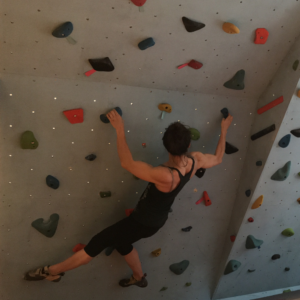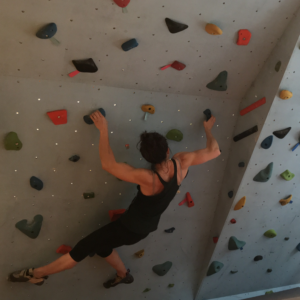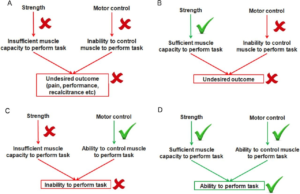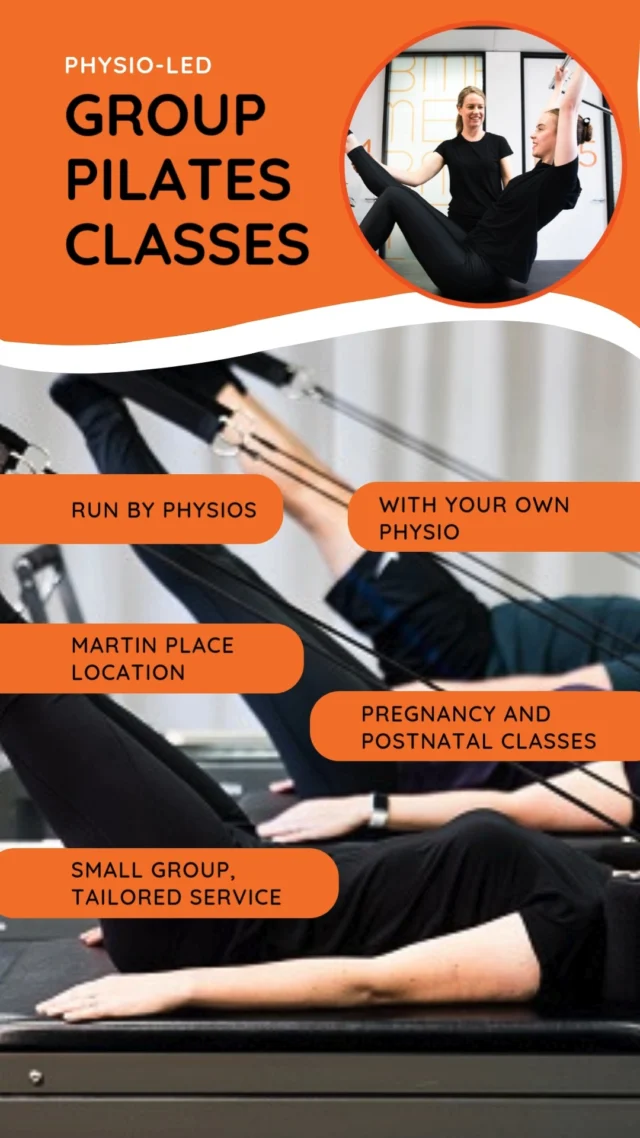The third part of the series dives a little deeper into medial epicondyle tendinopathy and looks at some assessments, exercises and rehabilitation tools you and your climbing physio might use together. Part two gave some tendon loading exercises that can produce significant recovery for climber’s elbow but if pain persists and you are still not back to full power other factors need to be considered as contributors.
- Look up the chain.
Climbing is a full body exercise and as technique improves climbers core, legs and shoulders get worked as much as elbows and fingers. Often one of the causes of the medial elbow pain is weakness around the shoulders. Over griping on holds, excessively pulling instead of driving through feet and allowing shoulders to “chicken wing out” when climbing can put more strain then necessary through the elbow.
Shoulder strengthening exercises can help you maintain optimal shoulder position when climbing and build a strong base for explosive movements. While warming up on easier climbs focus on good shoulder position to improve your capacity to do hard movements while climbing but reducing excessive loading in the elbow.
When we look at the body as an integrated moving structure it makes sense not to just focus on the elbow for treatment of pain. The muscles that flex our wrists and fingers also connect to the biceps, pectoral and latissimus muscles through the fascia in the body. Therefore, weakness or tightness in one area of the body can create increased force through the elbow further contributing to on-going elbow pain.
- Nervous system; flossing.
Often climbers report a feeling of constant tightness through the elbow along with pain. This can be cause by overloading of the flexor muscles but also from neural tension. The median, radial and ulnar nerve run from the neck into our fingers passing around different structures in the arm. When these nerves tighten they can often be the source of tension felt down into the elbow. Although stretching the forearms may feel nice we want help the nerve mobilize through the tissue through a process called neural tensioners. An assessment by a physiotherapist can help identify which nerve may be irritated and help you incorporate nerve glides into your rehab program.
- Nervous system: motor control
At the end of the day, the brain is boss. The brain controls our movement, pain perception, and ability to feel our body. We can enhance our rehabilitation outcomes by involving the brain using external cues, specifically a metronome. Ebonie Rio, an eminent physiotherapist in the field of tendon pain has done research showing the area of the brain responsible for movement does not function optimally in the presence of tendinopathy. People with tendinopathy show an imbalance between the action and inhibition of muscles. Essentially muscles are hitting the accelerator and break at the same time. Therefore, if we want to change how our brain sends signals to our muscles we need to also train the brain. One tool to do this is preforming exercises to the sound of a metronome. The metronome is an external cue and the brain needs listen and follow. Using a metronome with your rehabilitation exercises has been shown to guarantee time under tension and have positive motor neuron changes to muscles.
(Rio et al. 2015)
The goal is always to return to sport and stay training. With the right guidance and adherence to treatment we aim to get climbers affected by elbow pain back on the right track to recovery.
References:
Rio, E., Kidgell, D., Moseley, G. L., Gaida, J., Docking, S., Purdam, C., & Cook, J. (2016). Tendon neuroplastic training: changing the way we think about tendon rehabilitation: a narrative review. British journal of sports medicine, 50(4), 209-215.
Maffulli, U. G. Longo, How do eccentric exercises work in tendinopathy?, Rheumatology, Volume 47, Issue 10, October 2008, Pages 1444–1445, https://doi.org/10.1093/rheumatology/ken337
Kaux, J. F., Forthomme, B., Le Goff, C., Crielaard, J. M., & Croisier, J. L. (2011). Current opinions on tendinopathy. Journal of sports science & medicine, 10(2), 238.
McMullen, J., & Uhl, T. L. (2000). A kinetic chain approach for shoulder rehabilitation. Journal of athletic training, 35(3), 329.








